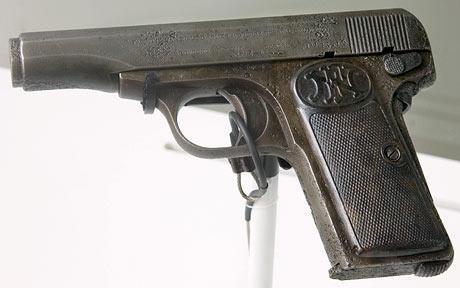This is the pistol Gavrilo Princip used to assassinate Archduke Franz Ferdinand of Austria on June 28, 1914, nearly 99 years ago. The Archduke was not exactly a beloved figure. He has been described as "a
man of uninspired energy, dark in appearance and emotion, who radiated an aura
of strangeness and cast a shadow of violence and recklessness." Yet he was the heir to the Austro-Hungarian throne, and so his murder began an odd but remorseless chain of causation that within weeks led to general war. By August, 1914, "the lamps [were] going out all over Europe," and before long the conflagration known as the Great War would engulf the whole world. When it was over, the Kaiser, the Tsar and the Habsburg Emperor had all lost their thrones (the Ottoman sultan would shortly lose his), while many new states had come into being, including a murderous communist regime in Russia. More than 16 million lives had been lost.
The pistol, a Browning semi-automatic manufactured in Belgium, was discovered recently in a Jesuit archive. Fr. Anton Puntigam, SJ, a family friend, had accompanied the Archduke and his pregnant wife to Sarajevo to observe military maneuvers. Fr. Puntigam administered last rites to the royal couple after they'd received their mortal wounds, and was given the pistol, as well as the Archduke's bloody shirt, for safekeeping. They were stored pending donation to a museum, and subsequently forgotten for more than 80 years. (h/t Good Jesuit, Bad Jesuit)
The pistol, a Browning semi-automatic manufactured in Belgium, was discovered recently in a Jesuit archive. Fr. Anton Puntigam, SJ, a family friend, had accompanied the Archduke and his pregnant wife to Sarajevo to observe military maneuvers. Fr. Puntigam administered last rites to the royal couple after they'd received their mortal wounds, and was given the pistol, as well as the Archduke's bloody shirt, for safekeeping. They were stored pending donation to a museum, and subsequently forgotten for more than 80 years. (h/t Good Jesuit, Bad Jesuit)




